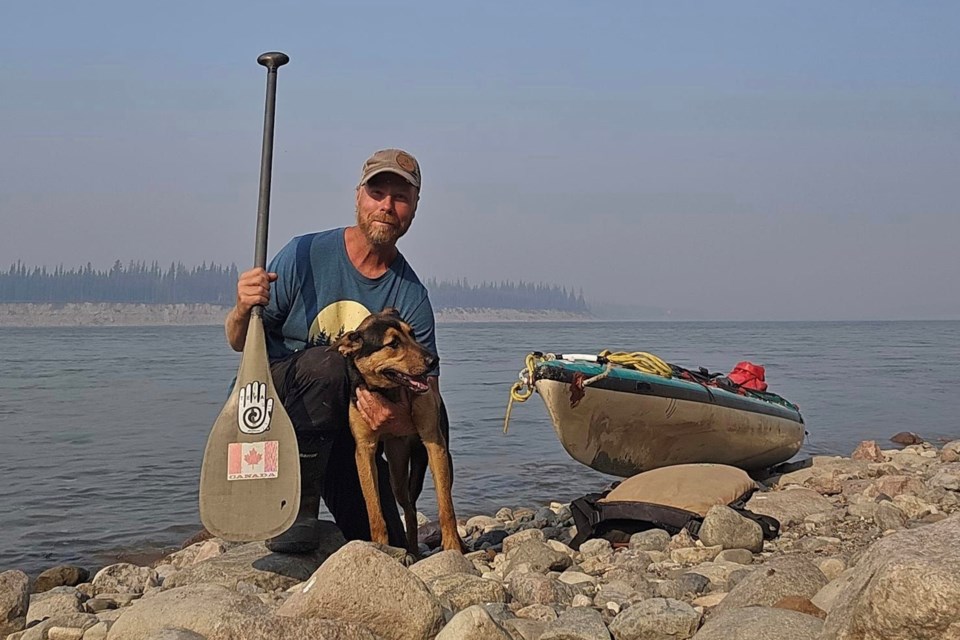FLIN FLON REMINDER — After going on the trip of a lifetime, paddler Dave Koop is back home - and he’s got some stories to share.
Koop is back in the Flin Flon area after embarking on a months-long, thousands-of-kilometre-long canoe voyage that took him to the Northwest Territories. Koop did not make his original goal, to paddle from his home at Schist Lake all the way to Tuktoyaktuk, where the Mackenzie River drains into the Arctic Ocean - he was forced to abandon his journey on day 87 at Fort Providence, NWT, due mainly to the wildfires that burned throughout the Northwest Territories late last summer.
For almost three months, Koop and his dog Taiga went through the wilderness, going through three provinces and a territory before having to head home.
In the past, Koop had done trips as long as 47 days through the Canadian tundra, stretching from Stony Rapids in Saskatchewan to Baker Lake, Nunavut.
“That was to sort of test my endurance level and see if I could do such a trip,” said Koop during a recent Culture Days presentation he held about his trip.
“It went very well and that was my sort of go-ahead, ‘Ok, I think I’m ready for a three-monther.’”
Planning the trip took significant time to prepare. Koop sold off the geotechnical company he owned, coordinated a series of supply and food pick-ups in different communities along the route and charted a course. The route he chose took advantage of long-established transport and trading routes used for millenia by Indigenous paddlers, fur traders, voyageurs and others.
“The river system that I paddled down, it hasn’t changed in a billion years. It’s the same paddling system that the explorers and the native paddlers have been paddling for all these years - what’s so cool about doing these rivers is you’re seeing it just like they saw it, just through your own eyes,” he said.
The trip started June 2 with a stretch from Schist Lake to Meridian Creek through to Amisk Lake - a stretch of water that was one of the most challenging parts of the trip. Once he reached Amisk Lake, Koop headed up the Sturgeon Weir river system, through Mirond Lake and Pelican Narrows, Pelican Lake, then onto the Churchill River, the Reindeer River and eventually, on to Reindeer Lake and Wollaston Lake in far northern Saskatchewan.
Supplies were not always easy to find and the Swan-Blondeau canoe route through northern Saskatchewan was tough, but both Koop and Taiga were in good spirits. but Koop’s body was holding up well, his companion Taiga was enjoying the outing and weather was mostly cooperative.
“I made up in my mind it was the breaking point for me - if I could get up to Wollaston Lake and was feeling good and my body wasn’t broken, then I knew I had a good go at finishing the whole trip,” Koop said.
“I was windbound for three days and I couldn’t get to Wollaston community to get my other supplies, so I ran short of supplies a week before getting to Stony Rapids - I had to rely on just fish and porridge.”
Despite the challenge, Koop kept on toward Lake Athabasca, then through Fort Chipewyan to the Slave River, which would take him to the far north. The river started narrow, then widened out and got more muddy, making camping on the riverside after a day’s paddling more of a challenge.
Heading further north, forest fire smoke began to be a factor for Koop. Once he hit the community of Fitzgerald, Alta., not far from the Northwest Territories border, the smoke began rolling in.
“The smoke was starting come right in on me there, it was getting heavier and heavier,” he said. It would get worse as he approached the Great Slave Lake.
“I got to Hay River and the whole area was on fire - there was fire coming toward the shore and I was trying to stay out of the way. That part was very scary," he said.
Despite the smoke and the fire, Koop pushed on along the southern shore of the lake, but eventually, the fire situation became too much to bear. After reaching the Deh Cho Bridge, marking the end of the Great Slave Lake and the beginning of the Mackenzie River, Koop had decided to call his trip early. He had made it 2,200 kilometres from home, picking up a ride at a gas station at Fort Providence before heading back home with his wife and her father, who were originally slated to pick up Koop from Tuktoyaktuk and head home.
Out of the experience, he said his favourite parts of the trip were the first times - his first times on different paddling routes, his first trip with Taiga, first time seeing new parts of Canada - and being able to connect with people through the trip.
“I really enjoyed the communities I went through - one of my favourite parts was meeting people along the way,” he said.
“I guess the whole conversation, when I got to communication, with people’s notes online and their feedback - I couldn’t believe how many people were interested in this thing and that really blew me away.”
Koop says he hopes to some day head back to Fort Providence to finish off the trip and says he appreciates the support he received along the way.
“I wasn’t doing anything that nobody else had done before - there’s been many travellers, Aboriginal and fur traders, who have travelled these routes for thousands of years. I’m just a guy who was out of shape and wanting to do the trip of a lifetime and it turned into something more along the way - spiritually, health-wise and all the talking, with people on Facebook and people’s kind notes.”




